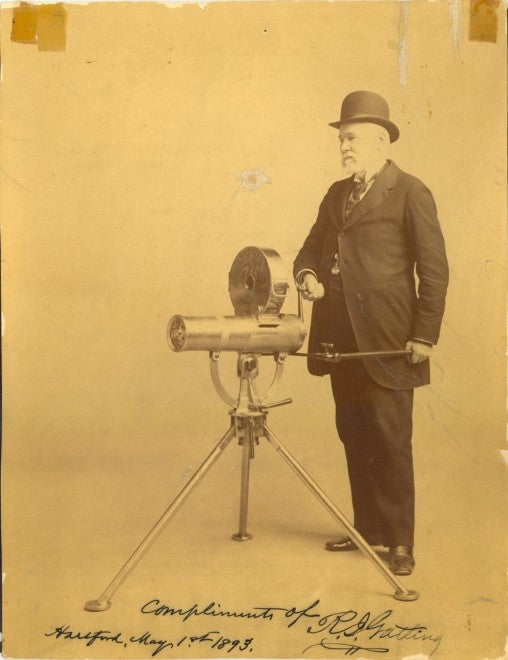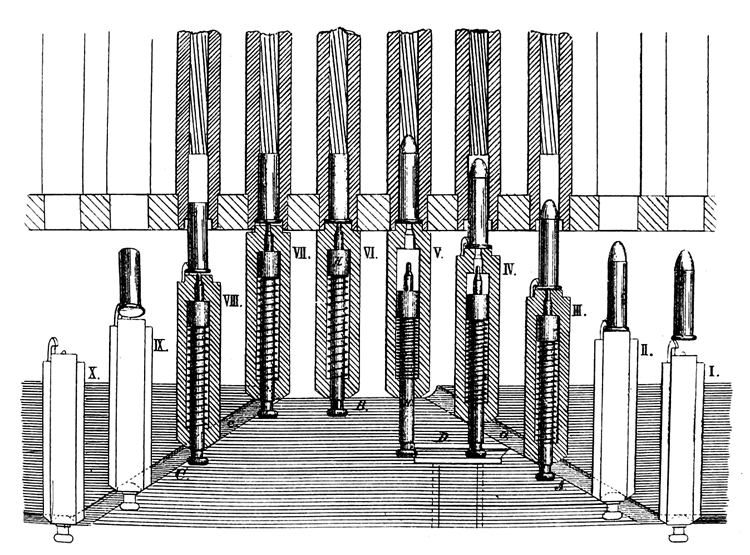Need a primer on the original manually-cranked Gatling gun? Of course you do, or you know someone who does. The Historical Firearms blog has what you need, with a lengthy post covering in modest detail the operation and history of the gun, from its origins as an improved “coffee mill” gun to its maturation as the premier manually-operated metallic-cartridge firing proto-machine gun:
Invented by Dr Richard Gatling in 1861 the Gatling Gun is the most famous of all manual machine guns. Cycled by the operator the weapon’s rate of fire was limited only by the speed of which it could be operated. With a number of barrels arrayed around a central axis and a top loading magazine which loaded each barrel in turn before the continuing turn of the guns crank fired the weapon. Famously inspired by Gatling’s hope to minimise the number of men needed to fight during the US Civil War, this flawed logic lead to a weapon which would be used throughout the world until it was finally surpassed in the 1890s by the Maxim Gun – a fully-automatic machine gun.
The basic design of Gatling’s gun was refined over its 40 year lifespan but the basic operation remained the same. The weapon had six to ten barrels each with its own bolt, firing pin and extractor with each barrel firing in sequence. Ammunition fed in from the top of the receiver with a single cartridge being loaded into each chamber. As the gun’s crank was rotated the action was cycled with the barrels turning through 360-degrees, each barrel had a cammed lock/bolt which fed the cartridges. When the barrel reached the 6 o’clock position of the cycle its firing pin was tripped by the movement of the barrel’s cammed lock firing the gun. The fired barrel then continued to travel clockwise and the spent case is pulled from the breech by the bolt which is being retracted by the spiralled cam. This process meant that each barrel was fired with one turn of the crank. Early models were capable of up to 200 round per minute but later models were able to fire much faster with rates ranging between 700 to 1,000 round per minute – the upper limit of a manually loaded and cranked action. This high rate of sustained fire was made possible by the Gatling’s numerous barrels, each barrel once fired had time to allow heat to dissipate unlike a conventional single barrel machine gun.
This linear diagram from 1878 shows how the Gatling’s action worked with the bolts moved by the spiraled cam which loaded, fired and extracted the ammunition (source)
Gatling was granted a patent for the ‘Improvement in revolving battery-guns’ on the 4th November, 1862 (see image #7). The first model Gatling Gun fed from a hopper which had been used on the earlier Agar ‘coffee mill’ Gun. The cartridge fired by the gun went through a rapid evolution through separate .58 calibre paper cartridges and percussion caps contained within what Gatling described as ‘cartridge chambers’ these self contained metal tubes held powder, percussion cap and projectile. These early reusable steel cartridges tubes led to problems with gas leakage but despite these problems the gun was reportedly able to fire up to 200 rounds per minute. The introduction of truly self-contained brass cartridges improved the reliability of feeding and by 1865 the weapon fed metallic rimfire cartridges from the gravity assisted hopper.
In part both because of the early problems of the Gatling, and its later success, the United States would fall behind in adopting true self-powered machine guns, with the Army adopting its first such weapon only as late as 1909.
 Your Privacy Choices
Your Privacy Choices

